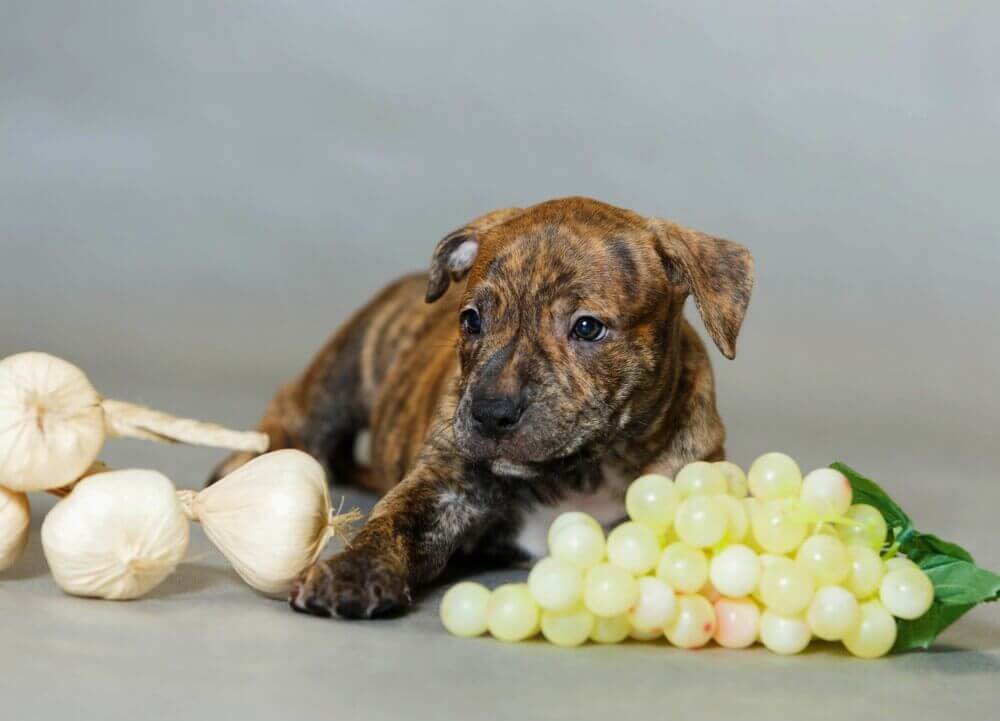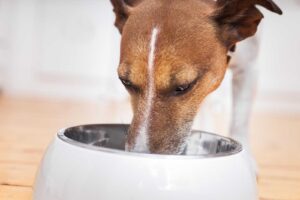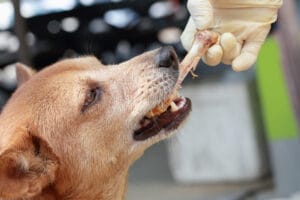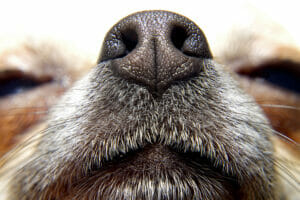Last updated: March 27th, 2025
Garlic seems like a dream plant with its human immune-system-boosting abilities and, of course, its Garlic is a flavorful and nutritious ingredient for humans, but can dogs have garlic? The short answer is no—garlic is toxic to dogs. While it has immune-boosting benefits for people, garlic contains compounds that can damage a dog’s red blood cells, leading to serious health risks like anemia.
If you’re wondering, “Is garlic bad for dogs?” or “Is garlic toxic to dogs?”, the answer remains the same: even small amounts of garlic can be harmful. Some pet owners believe garlic has health benefits for dogs, but the risks far outweigh any potential rewards.
Before you consider giving your pup food seasoned with garlic—like pasta sauce or leftovers—it’s important to understand why garlic is dangerous for dogs, how much is toxic, and what to do if your dog eats garlic.
Can Dogs Eat Garlic?
No, dogs should not eat garlic in any form. While garlic is a popular ingredient in human cuisine and is often praised for its health benefits, it is toxic to dogs and can cause serious health problems. Even small amounts can lead to garlic poisoning, making it essential to keep all forms of garlic away from your pup.
Garlic belongs to the Allium family, which also includes onions, leeks, chives, and shallots—all of which are harmful to dogs. The main issue with garlic is that it contains thiosulfates, compounds that are harmless to humans but highly toxic to dogs. These compounds can damage your dog’s red blood cells, leading to hemolytic anemia—a dangerous condition where red blood cells break down faster than they can be replaced.
Some pet owners believe that garlic has health benefits for dogs, such as repelling fleas or boosting the immune system. However, the risks far outweigh any potential benefits. Unlike humans, dogs cannot process thiosulfates efficiently, meaning that even small amounts of garlic can accumulate over time and lead to serious health complications.
Toxicity levels depend on your dog’s size, weight, and the amount of garlic consumed, but studies suggest that consuming just 15 to 30 grams of garlic per kilogram of body weight can lead to dangerous effects. To put this into perspective, a single garlic clove weighs around 5 grams, meaning that as little as one clove can be harmful to a small or medium-sized dog. Large dogs may tolerate slightly more, but no amount of garlic is considered safe. Additionally, garlic toxicity is cumulative, meaning that repeated small doses can eventually lead to serious health issues.
Garlic poisoning doesn’t always cause immediate symptoms. Some dogs may not show signs for a few days after ingestion, making it difficult to spot the problem right away. Symptoms to watch for include lethargy, weakness, pale gums, vomiting, diarrhea, rapid breathing, and dark-colored urine. In severe cases, dogs may require hospitalization, IV fluids, oxygen therapy, or even blood transfusions to recover.
A National Center for Biotechnology Information report states that garlic is toxic to dogs, but not as toxic as some other foods like onions. Onions and garlic both contain a toxin that can lead to anemia.
Is Garlic Safe for Dogs?
Is garlic toxic to dogs in all instances? Let’s consider what we know. Garlic and onions are closely related as part of the Allium family. And as you may know, onions are a big no-no for dogs.
While garlic can be unsafe for dogs, it is also important to note that how much garlic your dog has will determine how toxic the effects are.
Why is garlic bad for dogs? This all comes down to toxins. Garlic contains N-propyl, which is toxic to dogs in large doses.
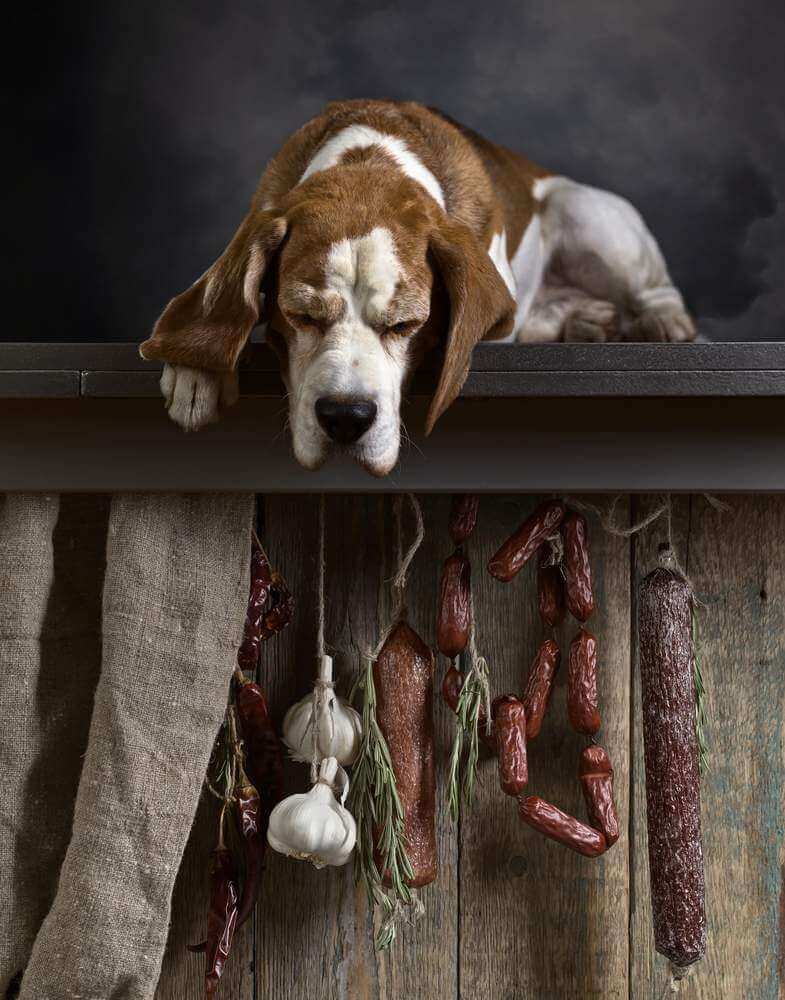
When consumed in high doses, the N-propyl gets to work, causing oxidative damage to your dog’s red blood cells, resulting in hemolytic anemia. Many people are confused that some garlic is allowed for dogs, but onion is a no-no.
This is because garlic contains less damaging toxins than onions – so a small amount may be safe. It has been found that onion can be 15 times more damaging to a dog’s blood cells than garlic.
Signs Your Dog Has Eaten Too Much Garlic
If your dog has too much garlic, he or she may show the following signs:
- Tiredness and lethargy
- Pale mucous membranes
- Rapid breathing
- Dehydration
- Discolored urine
- Weakness
- Jaundice
- Poor appetite
- Upset stomach and abdominal pain
- Vomiting
- Diarrhea
- Depression
What To Do If Your Dog Has Eaten Garlic
If your dog has eaten a little bit of garlic, don’t panic! While large amounts can be toxic, a small accidental bite is unlikely to cause serious harm. The key is moderation and awareness—while garlic in excess can be dangerous, tiny amounts found in some foods may not be an immediate cause for concern.
Step 1: Figure Out How Much Garlic Your Dog Ate
The effects of garlic depend on how much was consumed and the size of your dog. A small taste from a piece of chicken seasoned with garlic probably won’t cause harm, but eating a whole clove or a meal heavily flavored with garlic could be problematic.
As a general guideline:
- A small dog (under 20 lbs) may be sensitive to even half a clove of garlic.
- Medium dogs (20–50 lbs) could tolerate a clove or less without serious effects.
- Large dogs (50+ lbs) would likely need to eat several cloves before experiencing issues.
Since garlic toxicity builds up over time, regularly feeding garlic-seasoned foods can increase the risk of negative effects.
Step 2: Watch for Any Unusual Symptoms
If your dog has eaten a very small amount of garlic, they’ll likely be just fine! However, if they ate a larger quantity, keep an eye out for these symptoms over the next 24–72 hours:
- Mild stomach upset (occasional vomiting or soft stool)
- Decreased appetite
- Lethargy or tiredness
- Pale gums (a potential sign of anemia, but rare in small exposures)
In most cases, mild stomach discomfort will pass on its own. If symptoms become severe or persistent, it’s best to check with your vet.
Step 3: When to Call the Vet
If your dog ate a significant amount of garlic, it’s always a good idea to call your veterinarian for guidance. They may suggest:
- Monitoring for symptoms and keeping your dog hydrated
Offering a bland diet (like plain rice and boiled chicken) if their stomach is upset
Scheduling a check-up if you’re unsure about how much garlic was consumed
Immediate vet attention is only needed if:
- Your dog ate a large amount of garlic relative to their size (several cloves)
- They show persistent vomiting, extreme lethargy, or pale gums
Step 4: Preventing Future Garlic Mishaps
To keep your pup safe, here are some simple precautions:
- Avoid feeding heavily seasoned foods – A little garlic in broth or sauce isn’t usually a big deal, but plain, dog-friendly meals are always best.
- Store garlic safely – Keep garlic cloves, powders, and seasonings out of reach.
- Check ingredient labels – Some processed foods contain hidden garlic powder.
The Bottom Line
If your dog sneaks a tiny nibble of garlic, there’s no need to worry—they’ll most likely be fine! The concern arises when garlic is eaten in large amounts or frequently. When in doubt, keeping garlic out of your dog’s diet is the safest approach, but a small accidental taste isn’t the end of the world.
What are the Safe Garlic Doses for Dogs?
What are the safe doses of garlic for dogs? By now, you know that your dog may do just fine with small amounts of garlic, but it’s still important to know how much is too much for your particular dog.
NCBI studies have proven that there are safe doses of garlic for dogs. The study found that 0.5 to 1 oz of garlic per each 2 lb of body weight can lead to toxicity in dogs.
With these dosage measurements in mind, you can deduce that an 85-pound Labrador will need to consume just over 150 garlic cloves to suffer ill-health from it. That’s a lot of garlic! Of course, your dog’s size and weight have a significant role to play.
Below is a brief look at how much garlic should be safe for your dog, depending on size:
| Dog size | Safe Garlic Dose |
| 10 to 15 pound | Half a garlic clove |
| 15 to 40 pound | One garlic clove |
| 40 to 70 pound | Two garlic cloves |
| 100 pounds and above | Three garlic cloves |
Keep in mind that garlic clove sizes vary from 0.1 to 0.25 oz, and you don’t want to base your dosage on the largest clove size possible.
Can All Dogs Have Garlic?
Is garlic safe for dogs of any type? No, not really. While no breed is more affected by garlic than others, some dogs just shouldn’t have it.
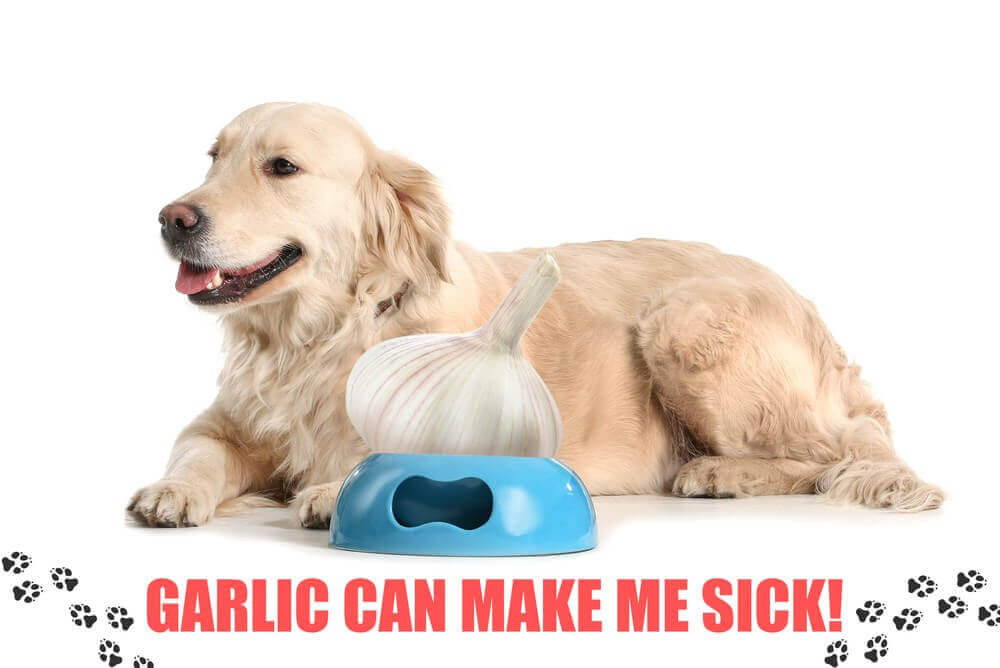
While we have ascertained that small doses of garlic can be good for dogs, it’s important to note that garlic should be ruled out entirely for some dogs. Do not give garlic to your pet if he:
- Is anemic – if your dog has an existing anemic condition or has an operation coming up, do not feed your dog garlic.
- Has lupus – lupus is an autoimmune disease that causes the body to turn on its own cells. As such, it’s not a good idea to feed a dog with lupus garlic, as garlic stimulates the immune system. Garlic may cause the immune system to become over-active.
- Is still a puppy – puppies only start reproducing new red blood cells at around two months old, so it’s best not to feed garlic to pups under two months of age!
Benefits of Garlic for Dogs
Now that you know that some garlic can be fine for dogs, you may want to find out what benefits it potentially offers dogs. Garlic does provide dogs with some health benefits, but it’s never a good idea to provide your dog with a regular garlic supplement.
If you’re wondering what the benefits of garlic in small doses might be and why you shouldn’t be entirely distressed if your pet has a little bit here and there, here’s a sneak peek.
- Garlic may enhance a suppressed immune system in dogs by boosting the red blood cells that eliminate destructive microbes.
- Garlic can be a tick and flea repellant. It doesn’t kill ticks and fleas, but it also doesn’t taste nice to bloodsuckers.
- Garlic is a natural antibacterial and antimicrobial which can help your dog’s system fight off infections.
- Garlic has good detoxifying properties and may help your dog’s liver eliminate pesky toxins from the body.
- Garlic can reduce fat build-up in arteries, lower cholesterol, and keep blood clots at bay.
Limited amounts of garlic can benefit your dog, as can a healthy, nutritious, toxin-free food.
You can give your dog amazing health benefits without garlic, too. One way to incorporate these health benefits into your dog’s diet is to opt for a fresh, human-grade food.
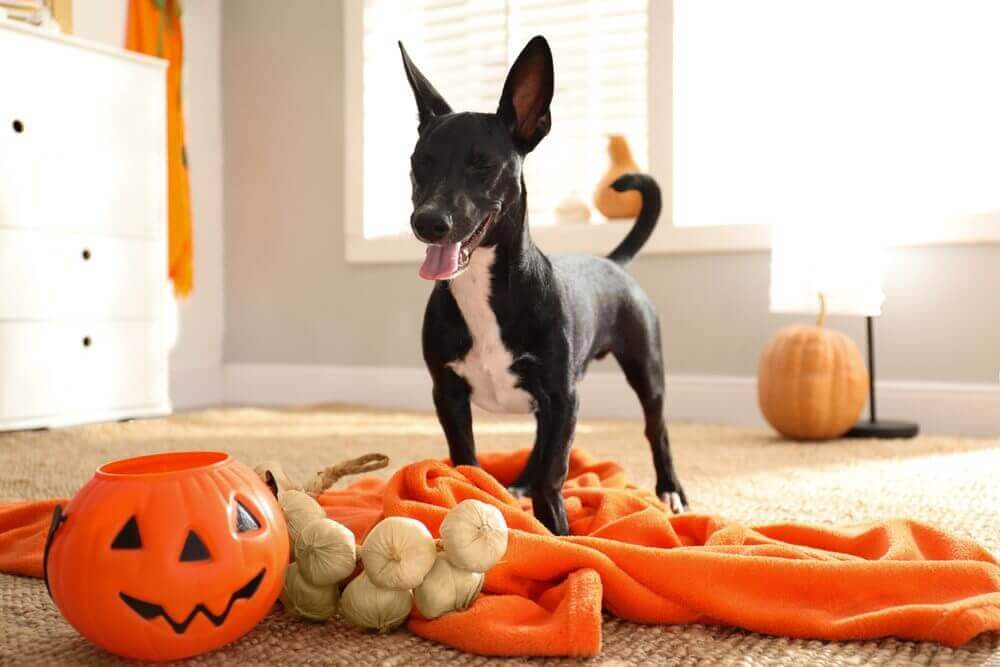
Spot & Tango’s recipes, which you can view here, are formulated by nutritionists with the utmost health of your dog in mind.
Fresh meals that are human-grade can also be arranged by Spot & Tango, based on the specific nutritional needs of your pet.
Spot & Tango takes the fear of garlic toxicity out of the equation by providing a high quality garlic-free, dog food packed nutrition without any of the “bad” stuff.
Frequently Asked Questions:
Q. Is garlic bread bad for dogs?
Garlic bread offers a dog no nutritional benefits. While garlic bread may not kill your dog, it’s not a good idea to feed it to him.
This is not solely because garlic is contained in the bread but also because it contains excess oil, butter, and sometimes even herbs and cheese. This can upset your dog’s stomach and add to your dog’s weight.
Q. Is cooked garlic good for dogs?
Cooked garlic will have the same effect on your dog as raw garlic. Cooked garlic is only safe for dogs in a suitable quantity/dose.
Q. Can I feed my dog garlic supplements?
You may find a few websites recommending garlic as a preventative plan for ticks and fleas and a wellness plan for your dog’s overall health. The positive results of studies done on using garlic regularly as a health supplement for pets have been quite inconsistent.
It may be acceptable to give your dog a bit of garlic now and then in a small dose, but it’s not a good idea to give your dog a regular garlic supplement due to the inconclusive information available.
If you are dead-set on providing your dog with a garlic supplement, always consult with your vet first, as overdosing your pet can lead to detrimental health implications.
Q. When to avoid feeding garlic to your dog?
As mentioned above, if your dog is a puppy, has lupus, or is anemic, you should exclude garlic entirely from his diet.
Q. My dog ate garlic. What should I do?
First, consider how much garlic your dog has eaten and your dog’s size. Refer to the dosing guideline mentioned above.
If you are unsure how much garlic your dog has eaten or if your dog has consumed a large amount, consult with your veterinarian immediately.
Conclusion
Is garlic bad for dogs to eat? Not entirely. While large volumes of garlic can be detrimental to your dog’s health, you don’t need to panic if your pet has had a small amount.
Of course, you shouldn’t supplement your dog’s diet with it daily, but in small doses, garlic can be good for your pet.
Building a personalized meal plan for your dog is a sure-fire way to ensure that your dog gets the best nutrition and faces none of the toxicity dangers you might fear. Use Spot & Tango’s recipes and meal plans to create a finely-tuned diet for your dog today.


